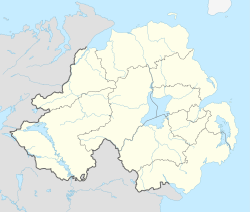Top Qs
Timeline
Chat
Perspective
Coagh
Village in counties Londonderry and Tyrone, Northern Ireland From Wikipedia, the free encyclopedia
Remove ads
Coagh (/koʊk/ KOHK; from Irish An Cuach, meaning 'the hollow'[1]) is a village in County Tyrone, Northern Ireland, five miles (8 km) east of Cookstown. Part of the village also extends into County Londonderry. It had a population of 774 people in the 2021 census. It owes its existence to George Butle Conyngham of Springhill, and was founded in 1728 when King George II of Great Britain granted Conyngham a market charter allowing the village to host four fairs yearly.[2] It is situated within Mid-Ulster District. The village is situated on gentle, low-lying land between the Sperrins and Lough Neagh.

Remove ads
History
The village has been an ancient settlement for several thousand years; overlooking Coagh is Tamlaght Stone, a Mesolithic dolmen erected c. 4500 BCE.[citation needed]
The main feature of the village is Hanover Square, which was named after the reigning Hanoverian George II by Conyngham.
The Coagh ambush, which took place during The Troubles, resulted in the deaths of three members of the Provisional Irish Republican Army (IRA). On 3 June 1991, IRA volunteers Lawrence McNally, Peter Ryan and Tony Doris were killed in the area by an SAS unit. The British Army stated that the IRA members had been intercepted on their way to an attack. Over 200 rounds were fired at the car carrying the three men.[3]
Remove ads
Amenities
Coagh has a doctor's surgery which serves local areas, such as Ardboe, Ballinderry, Moortown, Drummullan, The Loup and Moneymore.
The local primary school, Coagh Primary School, is a feeder school for a number of local secondary schools, including Cookstown High School.[citation needed]
Sport
The local association football club, Coagh United, plays in the NIFL Premier Intermediate League.
Demographics
19th century
The population of the village increased slightly overall during the 19th century:[4][5]
21st century
Coagh is classified as a small village or hamlet by the Northern Ireland Statistics and Research Agency (NISRA) (i.e. with population between 500 and 1,000 people). On census day in 2001, 29 April 2001, there were 545 people living in Coagh. Of these:
- 20.9% were aged under 16 and 20.4% were aged 60 and over
- 48.3% of the population were male and 51.7% were female
- 26.4% were from a Catholic background and 72.8% were from a Protestant background
- 2.3% of people aged 16–74 were unemployed.[6]
Remove ads
Coagh townland
The townland of Coagh is situated in the historic barony of Dungannon Upper and the civil parish of Tamlaght and covers an area of 616 acres.[7]
The population of the townland declined during the 19th century:[4][5]
In 1891, the town of Coagh, standing in the townlands of Coagh and Urbal, covered an estimated area of 13 acres.[4]
Remove ads
Politics
Summarize
Perspective

Since 1950, Coagh has formed part of the Mid Ulster constituency for Parliamentary elections, with this constituency also being used for elections to the Assembly and other devolved bodies from 1973 onwards. In Parliament, Mid Ulster has been represented by the abstentionist Sinn Féin since 1997, and in devolved elections Sinn Féin has been the largest party in the constituency since the 1996 election to the talks forum.
In local government, Coagh has been part of Mid Ulster District Council since it succeeded Cookstown District Council in 2015. Coagh sits within the ward of the same name in Cookstown DEA. Councillors for this DEA were first elected in 2014 and sat as part of a shadow council until Mid Ulster District Council formally took over in 2015.


While a part of Cookstown District Council, Coagh previously sat within the ward of the same name in Ballinderry DEA from 1981 onwards (with Ballinderry DEA having succeeded the earlier Cookstown Area B which existed from 1973 to 1981).
In both of these DEAs, Sinn Féin has been the largest party since 2011,[8][9] and were joint-largest in 2005, when Ballinderry DEA was uncontested due to the number of candidates being same as the number of available seats, and no election was held. On this occasion, Sinn Féin and the SDLP won two seats each, out of the six available.[10]
Since 1973, Coagh has been represented by the following councillors:
Remove ads
Notable people
- Jimmy Kennedy, Tin Pan Alley composer, grew up here.
- Stuart Dallas (born 1991), Northern Ireland international footballer, grew up in Coagh, having been born in Cookstown.[11][12]
See also
Wikimedia Commons has media related to Coagh.
References
Wikiwand - on
Seamless Wikipedia browsing. On steroids.
Remove ads


